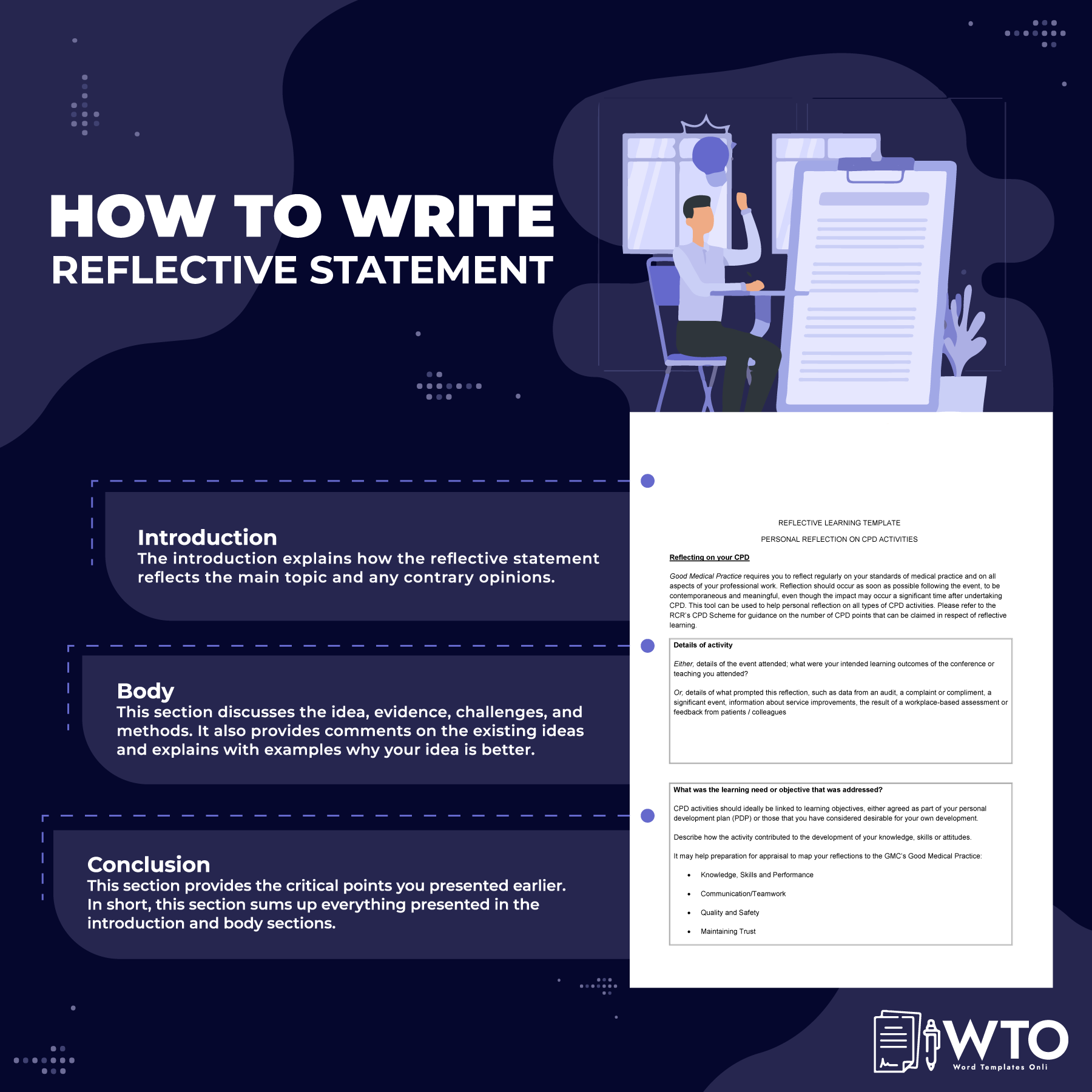As reflective statements find a good resting spot in Advanced English for year 11 and year 12 students, the need for perfecting reflection statements increases as the day goes by.
As you advance higher in high school, the niggling feeling about writing new kinds of content sets in. This article will guide you through the accurate steps to writing a better reflective statement. With consistent practice, writing content like this can become a piece of cake in no time.
What is It?
Students write a reflective statement to discuss the processes involved in achieving a task. This implies that it goes hand in hand with assessment tasks given by their teachers. The students involved can explain their decisions or performances on a task. In this statement, you are required to provide a summary of the processes you employed to complete an assessment. You concisely discuss what you did, your performance on the task, and what you can do better. It requires self-reflection on your decisions on a task.
Purpose of a Reflective Statement
The purpose of writing the reflective statement is to reflect. This is necessary, as students can reflect on their behaviors and strengthen their minds as they actively engage in self-reflection exercises. As these students reflect on the influences of their decisions towards a task, they become incredibly aware of all of their strengths and weaknesses. As a result, they can pass judgment on their performances and make better life decisions. It remains an essential skill for everyone, young students included.
However, writing this statement should never be done with an argument in mind. Though some arguments may be present in writing, your teachers will look for thoughtful comments and personal observations about you. Therefore, you should feel free to not argue with your written statement.
Tip
The primary way to know if your reflective statement is serving its purpose is if it answers one of these questions:
- Past reevaluation (How did I do in the task?)
- Present reflections (Where was I going?) (What were my goals?)
- Future concerns (What follows after?)
Criteria of an Effective Reflective Statement
Though no other person should have total control over someone’s self-reflections and thoughts, reflective statements have to be written in a certain way for you to score high with your markers. With this, it should include new and reflective thoughts on your task after you have actively done some self-reflection. You have to be extremely mindful and be influenced more by personal opinions, existing ideas, and knowledge of the task. Nevertheless, essential facts and knowledge should not be altered or skewed to prove a point, even with your personal opinions.
Your thoughts should be well organized and written for any audience to read and comprehend with ease. To add to that, you should be straight to the point when discussing a personal experience relating to the topic or task addressed. Finally, while writing this statement, you must show a reasonable degree and expression of clarity in your thought processes on paper.
Meeting these criteria while reflecting will streamline your thoughts and give more accurate explanations when you write the statement.
Assessment Tasks and Their Requirements
Different assessment tasks will require a slightly specific process. To simplify your task of bringing out the ideal reflective statement for the various assessments, this guide below will help you know if it serves its purpose for the different assessment tasks.
Some of the most common tasks and their requirements include:
Imaginative recreation
Articles here are written as an addition or response to an existing character or idea from a text or other content. In these articles, a remodeling of an existing text is done, so it seems new.
The requirements essential for this task are:
- It would be best to discuss what influenced your rewriting of the piece. For example, what or who made you recreate the content? You should explain briefly to your marker.
- As much as possible, you should reflect on and summarize what influenced your style, genre, and form.
- If something has piqued your interest from your source text to cause recreation of the text, discuss what it is and why you are trying to recreate the text.
- It would help if you summarily described the expressions and rhetoric employed, so every reader gets the point you are coming from.
- You must reflect on problems you encountered in trying to recreate the piece and discuss them. All the challenges you faced and the solutions you produced to solve the problems should be on paper.
Creative composition
This type of writing is purely imaginative and original. Since this piece is imaginative, a different requirement is utilized in writing a reflective statement to explain it.
Some of these requirements include:
- You should reflect on and discuss your source of inspiration for the piece. The reader needs to understand why you wrote in the context you did.
- You must explain what affected your writing style. Your motive is to carry them along all the way, not halfway.
- It would be best if you discussed the themes of your piece to give the reader a broader understanding of your article.
- Expressions used in your piece of writing must be mentioned. In addition, idioms, rhetoric, and other figures of speech should be explained for clarity in your work.
- You must reflect on problems you encountered while trying to recreate the piece and discuss the solution you came up with to solve them.
Non-fiction composition
This is a well-written, attention-grabbing, and convincing piece that may be written as a newspaper or magazine article or as a journal entry.
The reflection requirements you should apply while writing articles that fall into this category are:
- You must summarily discuss what would have affected your choice of topic or subject if your article is focused on a person.
- It would be best to describe your inspiration for choosing the writing style used in the task.
- The goals your statement will achieve after being read should be reflected. Your task should meet your set goals.
- You must explain briefly the reasons you used some uncommon expressions, idioms, and rhetoric in your article.
- You should discuss the challenges you encountered on the task and the solutions to the problems you could solve if you did.
Speech
A speech is an article written for presentation to an audience. Your audience, in this case, is your classmates and some of your teachers. Since this involved presenting to a ready audience, the reflective requirements for this task are:
- You should reflect on the challenges you may have faced in writing the presentation. Then, add the solutions preferred to solve the challenge.
- The strengths and weaknesses of your speech, in comparison to those written by your classmates and other professional speech writers must be discussed.
- Your choice of standpoint must be discussed. Why did you choose your subject?
- You must discuss your choice of themes and used expressions if they are uncommon, so the reader flows with them.
Listening tasks
In tasks like this, your listening ability is tested. You listen to a speech, presentation, or audio to draft a summary, response, or question.
Because this requires active listening, the requirements for writing a reflective piece for this task are:
- It would be best to discuss the challenges you experienced while listening to the audio. This is different from the others, as your main task involves listening.
- You will also need to talk about the reasons for your responses to the audio. But, again, make it as short as is required.
- If it is a presentation you listened to, discuss the strengths and weaknesses you observe and suggest possible improvement solutions.
- You should summarize lessons learned from the material played.
Group presentation
You and some of your classmates do this kind of presentation to discuss a subject collectively. Scores earned from articles done by a group are collective. The requirements you need for this assessment before drafting your statement are:
- You should discuss the challenges you faced working with other people as a team to achieve the goal.
- You should briefly discuss how you can improve your contributions to the assignment if another group’s work is given next time.
- You should reflect and discuss the strengths and weaknesses you and your colleagues show in the course of the presentation. Then, proffer a solution, if you have any.
Essay tasks
This is simply a written essay with subtle differences from a standard composition. The requirements needed to write a reflection statement after this task are not specific, as are others. Some include:
- You will need to discuss why you chose your choice of sentence structure in your reflective piece.
- You should reflect on and discuss challenges encountered in attending to the task. Then, review and rewrite the piece again.
Pre-Considerations
You can’t go on to produce an excellent reflective statement if you haven’t thought twice about some significant facts.
For a well-written reflection, you need to:
Write a piece of work
Before you can draft a brilliant reflective statement to amaze your teachers, you need to perform excellently on your primary task/ assessment, which will serve as a guide for your reflective piece. You won’t produce any work if the main task is not completed and edited.
Reread what you have written on your primary task
Your reflection statement should be in line with your main task. First, your main task should be read over again to quickly evaluate all you have done and reflect on the job. Making side notes as you reread the main task collects your thoughts and gets your reflection on the point. After doing this, specific questions should be answered at this point before planning your reflective statements.
Questions that should be answered after thorough scrutiny on completion of the assessment are:
- What is my motive for writing this task this way?
- Does my task adhere to the instructions of the teacher?
- What methods did I use to convey my ideas?
- Are these methods factual?
- Is there a more effective way of conveying my ideas?
Planning the reflective statement
Properly planning every task keeps you prepared and actively engaged in the piece. Planning involves intense thinking and proper reflection. With appropriate planning, your statement is constructed with suitable compositions, keywords, and structure to convey your idea of writing the piece. Planning involves reading through the side notes you made, deep thinking, and drafting a piece of the reflective statement in the correct order in which it should appear.
It should contain the introduction, body, and conclusion sections, as with every written piece:
Introduction
The introduction part should contain the following information:
- Introduce your main piece of writing: Briefly introduce what you would be reflecting on, that is, your main task. Then, if you have a contrary opinion to facts, present them in this piece.
- Explain how this reflects your work: Try to make the reader understand how this statement reflects your main point. Clearly stating this at the beginning makes the reader read with an open mind.
Body
This part should contain the following information:
- Discuss the idea you are trying to convey: In a few sentences, discuss the idea of your main task after proper analysis and evaluation of your task. This is to achieve a clear reflection statement.
- Pick an example of that idea: Bring up an example to support your stance on the subject matter. Always remember to start with your most vital point.
- Describe your attempt to explore the idea: Challenges you faced to finish your main task should be discussed. In addition, all attempts made to explore your idea choice should be included.
- Comment on other options you may have chosen: Similar and other exciting ideas may have been available before you picked your idea to work on. Concisely, list these options and explain briefly why you didn’t choose them.
- Explain why you chose your idea: Explain why you chose your primary idea in a short paragraph, capturing the main details of all you want to convey. This paragraph should highlight your idea.
- Give a few more examples and repeat the procedures for the first: To bolster your points, add a few examples to support the first idea in your reflective statement. Make sure, however, that your points are in line with the guiding rules stated by the teacher.
Conclusion
Every article should have an excellent conclusion to add to all you have explained in the body section. The essential points you mentioned earlier should be highlighted briefly again. Remind the reader of the critical points of your argument before they finish reading. Finish off with a thoughtful statement to further impress the scorer. Make a statement while you do your reflection.
NOTE
How long should the reflection statement be? Depending on the task you are working on, the English course level, and the rules to meet to score high points with your marker, the length of your statement will vary. However, reflections are generally written within 300-800 words. For higher English levels, up to 1500 words are required.

Reflective Statement Examples
The examples attached should give you a better understanding of what your draft should be. A few tweaks can be made to these samples to suit your assessment requirements using the above guide.
Example 1: Imaginative recreation
(Character: Emily, a Year 11 student who loves literature.)
Introduction: I rewrote the last chapter of “Pride and Prejudice,” focusing on Lydia Bennet’s perspective.
Body: I was always fascinated by Lydia Bennet’s carefree character. My version offers her perspective, shedding light on her vulnerabilities. I faced challenges in capturing the 19th-century tone while adding modern sensibilities.
Conclusion: This task was enlightening, forcing me to consider multiple viewpoints in a well-loved story. It was an opportunity to explore the struggles of a side character often dismissed as frivolous.
Example 2: Creative composition
(Character: Mark, a Year 12 student who is passionate about the environment)
Introduction: My poem, “Whispers of the Forest,” addresses the existential threat facing our environment.
Body: Inspired by my hiking trips, I employed free verse and imagery to evoke the urgency of environmental protection. I pondered long about choosing this over a more traditional format like a sonnet, but free verse offered the raw emotion I wanted to convey.
Conclusion: This was an intense journey that forced me to reconsider my own responsibilities towards nature. The challenge lay not just in writing but in the self-reflection that the task prompted.
Example 3: Non-fiction composition
(Character: Sarah, a Year 11 student interested in journalism.)
Introduction: I wrote a feature article on the increasing instances of cyberbullying among teenagers.
Body: The topic was chosen after witnessing a friend experience cyberbullying. I used a narrative style to connect with the reader emotionally. One challenge was ensuring that my piece remained objective while still advocating for a cause.
Conclusion: This task was an eye-opener, making me realize the power of well-researched, compelling writing. It also served as a lesson in empathy and responsible journalism.
Example 4: Group presentation
(Character: Ahmad, a Year 12 student who is a natural leader.)
Introduction: Our group presented on the topic “Impact of Social Media on Mental Health.”
Body: I was responsible for the section on ‘Positive Impacts,’ and my challenge was balancing this against the largely negative aspects covered by my peers. Working in a team had its ups and downs, as coordinating schedules was often tough.
Conclusion: I learned not only about the topic but also about the dynamics of teamwork. The presentation served as a collective journey towards understanding a multifaceted issue.
Tips
After writing your statement, you should crosscheck the proof and edit it before submitting it.
To effectively edit, you must follow these tips:
- You must reread the summary of the primary assessment. This is to give you a better idea of your task.
- After you’ve reread and written the first draft, read it aloud to yourself. This should help you notice spelling and grammar mistakes. Correct these mistakes once you see them.
- Try to reflect on the written piece again. Are your ideas factual? Can your ideas be agreed upon?
- As much as possible, be keen to observe if you play by the rules stated by the marker. If not, rewrite your reflection until all the rules are strictly adhered to. You won’t score points if the rules are not followed.
- You should redraft your reflection statement after checking for these criteria, and you can submit the new draft.
Conclusion
Writing a reflective statement that impresses your teacher requires consistent writing practice and active engagement of your mind to self-reflect. In addition, a remarkable statement requires all the effort you can put in to give your best.
In submitting your best, you have to be 100% sure you adhere to the rules set by your teacher or any other marker. Your reflection serves the purpose of giving an insight into the main task and not muddling everything up and adding to the confusion.




